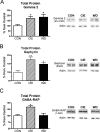Chronic ethanol and withdrawal differentially modulate lateral/basolateral amygdala paracapsular and local GABAergic synapses
- PMID: 21209156
- PMCID: PMC3063746
- DOI: 10.1124/jpet.110.177121
Chronic ethanol and withdrawal differentially modulate lateral/basolateral amygdala paracapsular and local GABAergic synapses
Abstract
Withdrawal-related anxiety is cited as a major contributor to relapse in recovering alcoholics. Changes in lateral/basolateral amygdala (BLA) neurotransmission could directly influence anxiety-like behaviors after chronic ethanol exposure and withdrawal. We have shown that these treatments enhance BLA glutamatergic function and neurotransmission. However, the BLA GABAergic system tightly controls the expression of anxiety-like behavior, and additional neuroadaptations in this system are potentially important as well. The intrinsic BLA GABAergic system consists of at least two populations of interneurons: local feed-back interneurons scattered throughout the region and feed-forward interneurons concentrated within groups found in the lateral/paracapsular region of the BLA. In the present study, we found that withdrawal from chronic ethanol robustly decreased presynaptic function at feed-forward GABA synapses but did not alter neurotransmitter release from local interneurons. Differential presynaptic changes at these synapses were complemented by decreased zolpidem sensitivity at feed-forward synapses and decreased midazolam sensitivity at local synapses. Consistent with this, chronic ethanol/withdrawal decreased expression of GABA α1-subunit total protein and increased surface expression of α4-subunit protein. We also found transient increases in GABA-receptor-associated protein levels and persistent increases in γ2-subunit and gephyrin proteins that would suggest alterations in GABA(A) receptor trafficking that might help regulate changes in α4-subunit localization. These data together suggest that chronic ethanol and withdrawal differentially modulate local and lateral paracapsular cell GABAergic synapses via distinct presynaptic and postsynaptic mechanisms. These findings extend our understanding of the neurobiological mechanisms governing changes in anxiety-like behavior after chronic ethanol exposure and withdrawal.
Figures






References
-
- Barberis A, Petrini EM, Cherubini E. (2004) Presynaptic source of quantal size variability at GABAergic synapses in rat hippocampal neurons in culture. Eur J Neurosci 20:1803–1810 - PubMed
-
- Cagetti E, Liang J, Spigelman I, Olsen RW. (2003) Withdrawal from chronic intermittent ethanol treatment changes subunit composition, reduces synaptic function, and decreases behavioral responses to positive allosteric modulators of GABAA receptors. Mol Pharmacol 63:53–64 - PubMed
-
- Diaz MR, Christian DT, Anderson NJ, McCool BA. (2011) Dopamine D3-like receptors modulate anxiety-like behavior and regulate GABAergic transmission in the rat lateral/basolateral amygdala. Neuropsychopharmacology doi:10.1038/npp.2010.246 - DOI - PMC - PubMed
-
- Essrich C, Lorez M, Benson JA, Fritschy JM, Lüscher B. (1998) Postsynaptic clustering of major GABAA receptor subtypes requires the γ2 subunit and gephyrin. Nat Neurosci 1:563–571 - PubMed
Publication types
MeSH terms
Substances
Grants and funding
LinkOut - more resources
Full Text Sources

